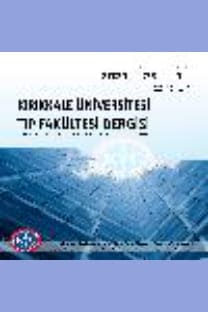Tonsillektomi Sonrası Geç Kanama - Olgu Sunumu
Post operatif kanama tonsillektomi sonrası görülen en yaygın ve en korkutucu komplikasyonlardan birisidir. İlk 24 saatte görülen primer kanamalar daha sıktır ve genellikle yetersiz hemostaza bağlıdır. Sekonder kanamalar ise daha az görülür; ancak daha korkutucudur. Postoperatif dönemde kanama çocuk popülasyonda erişkinlere oranla daha az sıklıkta görülmektedir. Preoperatif dönemde tam kan sayımı, hemostaz parametreleri, kanama ve pıhtılaşma süreleri incelenmelidir. Onbir yaşında adenotonsillektomi operasyonu yapılan ve preoperatif hematolojik parametreleri normal olan erkek hasta, postoperatif 19. günde abondan kanama ile başvurdu. Hastanın muayenesinde sağ tonsil lojunda aktif kanama ve ağız içinde yoğun pıhtı mevcuttu. Hastaya genel anestezi altında lokal Ankaferd tampon uygulanması, elektrokoterizasyon ve plika sütürasyonu uygulamaları yapıldı ve kanama kontrolü sağlandı. Traneksamik asit ve K vitamini uygulandı. 1 ünite eritrosit süspansiyonu ve taze donmuş plazma ile replasman yapıldı. Klinik durumu stabil olduktan sonra Pediatrik Hematoloji tarafından faktör düzeyleri istenen hastanın Faktör 7 ve 13 düzeyleri düşük olarak değerlendirildi. Minör faktör eksiklikleri preoperatif dönemde rutin olarak incelenen hematolojik tetkiklere yansımamasına rağmen tonsillektomi sonrası geç kanamaya neden olabilmektedir. Bu nedenle tonsillektomi sonrası sekonder kanamayla başvuran olgu, kanama başlama zamanı, hematolojik parametreler ve klinik yaklaşım açısından literatür eşliğinde sunulmuştur.
Pages 50-52
Post operative haemorrhage is the most common and frightening complication after tonsillectomy. Primary haemorrhage seen in the first 24 hours is more common and generally related with inadequate hemostasis. Secondary haemorrhage is rare, but more frightening. Post operative haemorrhage is less common in pediatric population than in adult population. Complete blood count, hemostatic parameters, bleeding and coagulation time should be examined before surgery. An eleven-year old male patient was admitted to the hospital with abundant haemorrhage who had undergone adenotonsillectomy operation 19 days before admission.His hematological values were normal preoperatively Active bleeding in the right tonsil bed and conglomerated clot in the oral cavity were seen in the physical examination. The patient was taken to sugery in general anesthesia and local Ankaferd blood stopper dressing, electrocauterization and plica suturation were performed and eventually bleeding was stopped. Tranexamic acid and vitamin K were administered also. 1 unit of erythrocyte suspension and fresh frozen plasma were also transfused. After achievement of clinical stability, coagulation factor levels were examined by the Pediatric Hematology department and Factor7 and Factor 13 levels were found lower than normal. Although minor coaagulation factor deficiencies do not effect the hematological tests performed before surgery, it can cause late post-tonsillectomy haemorrhage. Therefore, this case with secondary haemorrhage after tonsillectomy was presented focusing the initiation time of bleeding, hematological parameters and clinical management with the ligth of recent literature.
___
- Windfuhr JP, Schloendorff G, Baburi D, Kremer B. Lethaloutcome of post-tonsillectomyhemorrhage. Eur Arch Otorhinolaryngol. 2008; 265: 1527–34. Werle AH, Nicklaus PJ, Kirse DJ, Bruegger DE. A retrospectivestudy of tonsillectomy in theunder 2yearold child: indications, perioperativemanagement, andcomplications. Int J Pediatr Otorhinolaryngol. 2003; 67: 453-60.
- Krishna P, Lee D. Post-tonsillectomy bleeding: A meta analysis. Laryngoscope. 2001;111:1358-61. Lee MS, Montague ML, Hussain SS. Posttonsillectomy hemorrhage: cold versus hot dissection. OtolaryngolHeadNeckSurg. 2004;131:833-6.
- Lassaletta L, Martin G, Villafruela MA, Bolanos C, Alvarez-Vicent JJ. Pediatrictonsillectomy: post operative morbidity comparing microsurgical bipolar dissection versus cold sharp dissection. Int J Pediatr Otorhinolaryngol. 1997; 41: 307-17.
